Hello my dear readers.
As most of you now know, the Boy is the creative genius behind a lot of the spectacular cooking that gets put up on this blog (You may remember the Halloween post from last year).
You may say I’ve somehow absorbed a lot of his creativity in my own cooking throughout the years and have decided to pay him his dues on my blog.
This Playground Series is the creativity outlet he has chosen to share with you.
You could probably say, he’s the mad genius half of me (and this blog). He also has a lot more patience than I do, hence why he bothers with experimental cooking (as per below).
I shall say no more (he also wrote this post), so please sit back, and let your eyes and imagination feast!
Welcome to the first post of the Playground Series…
Before we begin, please note that the Playground Series are mostly trial and error experiments. Some measurements given are just estimates as there is no set recipe to follow.
I’m sure there are many ways of creating a Deconstructed Bak Kut Teh dish but I’ve gone with this one. Inspiration for the BKT spheres were drawn from Alvin Leung’s (Bo Innovation) Molecular Xiao Long Bao. Sure you could say, “Why use that when you could use this?” or “This doesn’t pair with that” or “Damn, using those rice puffs makes it look like a bunch of maggots slugging around” and so on. And I say that there’s no one right way of deconstructing anything (but yeah, they do look like maggots, come to think about it. But crispy, they are!). The possibilities are endless, but hey, we could always start here.
Ingredients:
Bak Kut Teh broth (filtered through a muslin cloth)
5-6 pieces of Pork Belly (preferred) or other meaty pork cuts from the Bak Kut Teh
5-6 Tbsp of Puffed Rice
3 pieces of Fried Tofu Puffs (Tau Pok) – sliced in halves
Sriracha Chilli Sauce
Soy Sauce
Coriander – for garnishing
1 tsp of chopped Chillies – for garnishing
For the Reverse Spherification:
Xanthan Gum powder (0.28%-0.30% *varies according to your broth)
Calcium Lactate powder (3.5-3.75% *varies according to your broth)
For the Setting Bath:
1000ml of Water (preferably bottled or filtered water, avoid using tap water as calcium levels vary in them and can affect your bath)
5g Sodium Alginate powder (0.5%)
Equipment:
Hand/Immersion Blender
Measuring Spoon
Slotted Spoon
Digital Scale (with at least 0.1g precision)
Syringe (optional)
Procedure for BKT Reverse Spherification:
Prepare the setting bath first as it requires the longest time to set unless you have a Cryovac vacuum sealer to spare. Dissolve the Sodium Alginate powder in the water using a hand/immersion blender. Strain the solution through a fine sieve and leave overnight in the refrigerator to allow air bubbles to escape.
It is important to remember that each Bak Kut Teh broth varies in terms of thickness/lightness, calcium content and other factors that may affect the amount of hydrocolloids needed. Our broth is a day old and therefore, more flavourful and concentrated compared to the day before. I’m assuming this in turn would result in a lesser quantity of Xanthan required to thicken the broth.
Dissolve the Calcium Lactate powder (used because it leaves a less bitter taste compared to Calcium Chloride) into your Bak Kut Teh broth. Separate your broth into 2 bowls. Take the first bowl and dissolve the Xanthan Gum powder with a hand blender (hopefully this would help reduce the number of air bubbles produced as the aggravated mixing takes place only in the first bowl). Mix solution from the first bowl with the second bowl without using the hand blender, just the ol’ fashion way of mixing it together. Strain the solution or vacuum pack it to remove air bubbles.
Take your Sodium Alginate bath out of the refrigerator. Using a syringe, fill a measuring spoon (1 tsp/5ml) with your Bak Kut Teh mixture and with a steady flick of your wrist, pour the contents into the Sodium Alginate bath. Use your fingers to help shape the sphere. And let the spheres “cook” in the bath for approximately 4-5 minutes (cooking time depends on the size of your spheres, larger takes longer).
Using a slotted spoon, gently remove the spheres and place them into a bowl of cold water to wash away any excess alginate solution. Remove them again using the slotted spoon and gently place them into a bowl of warm Bak Kut Teh broth (original broth without any alteration) and keep them covered. Try to keep the spheres as warm as possible.
Plating Up:
Strategically place your tofu puff halves around the plate (evenly spaced). This should act as a marker for where you want the BKT spheres to be. Take chunks of pork belly/other pork cuts and place them next to the tofu puffs. Remove BKT spheres (except for 1 sphere) from the bowl and place them on each tofu puff. Place a coriander leaf on each sphere for garnish.
Take puffed rice and place them next to each tofu puff. Place soy sauce and Sriracha chilli dots around the plate.
For the BKT Shot: Fill a shot glass 3/4 full with some warm Bak Kut Teh broth. Remove the last BKT sphere from the bowl and gently transfer it into the shot glass. Garnish with chopped coriander and chillies. Place glass on the same serving plate.
Finally, fill a small glass beaker with piping hot Bak Kut Teh broth and place it on the serving plate. And there you have it, a Deconstructed BKT.
Issues:
I found the BKT liquid released a tad too thick (and a slight bitterness) which is most probably due to too much Xanthan. But as explained earlier, the amount of powder required all depends on how thick/rich your broth was initially. I made the mistake of using a tad too much. You still get that burst when it “pops” in your mouth but in a form of a thicker liquid.
It was also slightly weird having cold BKT broth in your mouth and therefore, I recommend serving it immediately after plating up. Chunks of the pork meat should also be kept in its broth while waiting to plate up to avoid losing moisture (you can see that the pork is slightly dry from the pic above). But you could always dip the pork into the hot broth (served in the glass beaker) to “rehydrate” it.
Another common issue is air bubbles. Damnsss yousss air bubbles. I still had air bubbles (did not use a vacuum sealing machine for obvious reasons… I don’t have one!) in both solutions. It’s difficult to get rid of all the air bubbles but I’ve tried to minimize them by sieving and leaving it overnight (for setting bath). If you have air bubbles, your spheres tend to float in the bath.
And yes, more practice is required in getting the spheres right! Not all spheres turned out (some were deformed spheres). Oh well, there’s always next time. But at the moment, the biggest issue so far is trying to get the right amount of Xanthan required.
I agree presentation could’ve been better. I was in a rush. Our guests were getting hungry. So feel free to plate up however you want to! Add your own elements to the plate. Be creative!
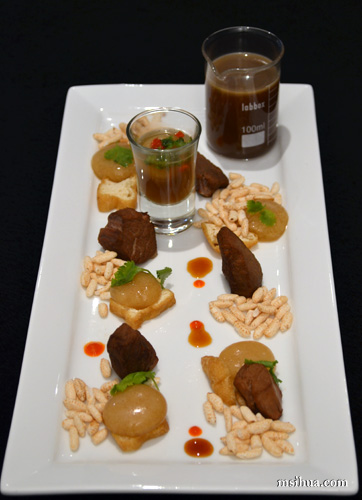
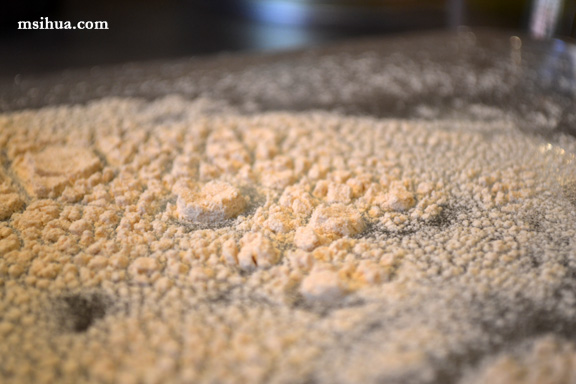
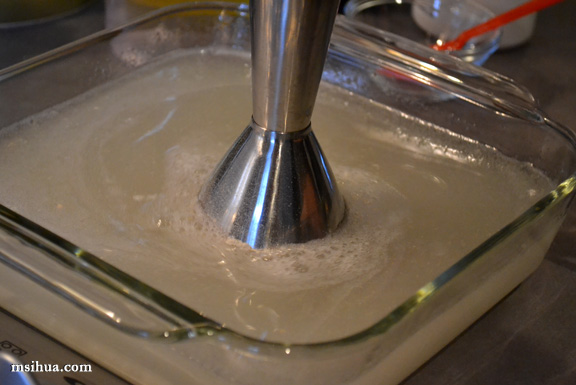

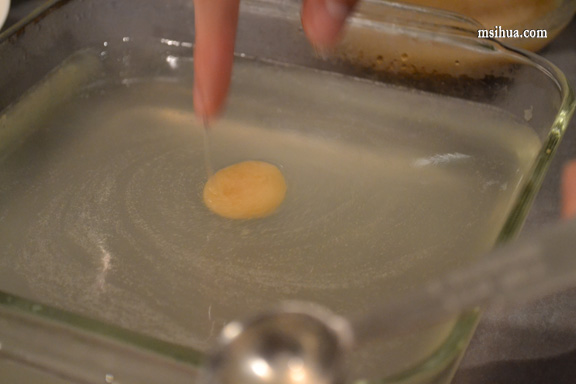
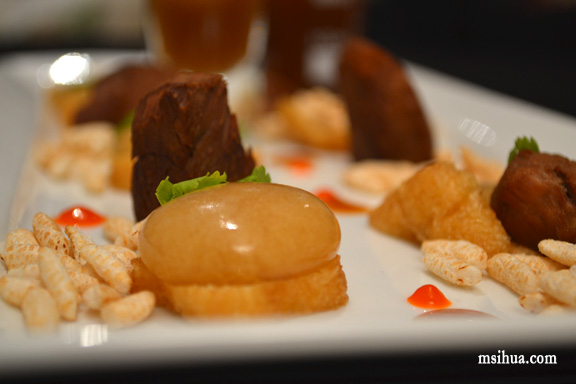
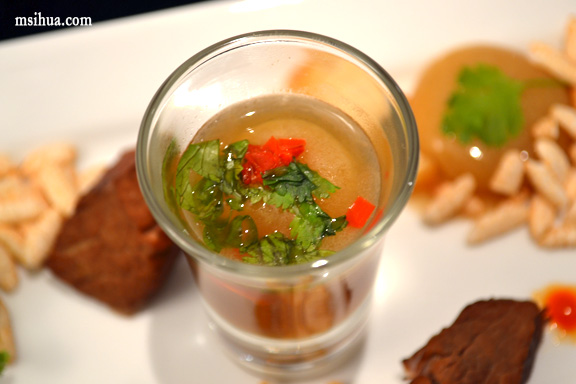
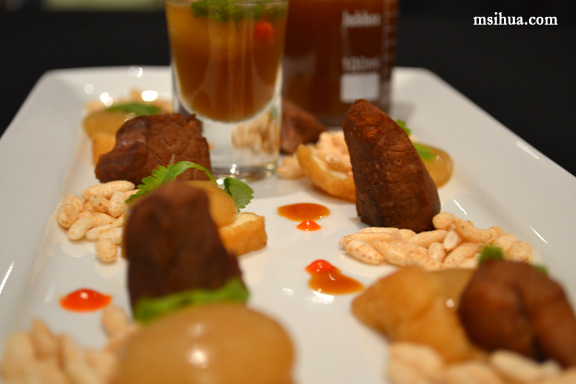
OMG! This is so darn pro. Man, someone should make this!
Someone has! US!! 🙂
Nice to see that you guys are experimenting with food. Good job!
it was fun…:)
You are so creative! Seriously, love this playground series idea too 😀
Aww shucks… I didn’t do anything apart from playing with the BKT balls.. hee hee
Oh The Boy, don’t worry. I didn’t think they were maggots. I thought they were witchetty grubs. 😉
Jokes aside, this is AMAZING! I’ve actually never bothered to read a post about molecular gastronomy anywhere else before, but this actually makes sense to me and I enjoyed reading it 🙂
My darling Ms. Rake Sway, how on earth did you manage to find a boy with both cooking and computer geniusness? I bow down to your feminine wiles, and would like you to teach me your man-catchin’ tricks .
Feminine wiles I have not.. a whip I have… HAHAHHAHA… nono.. don’t take that seriously at all.. I’m quite amazed at how I got him as well… It’s a miracle!
WOoow, so amazing! 🙂 Very creative and interesting, Asian dishes (especially South East Asian dishes) aren’t commonly deconstructed, so this is certainly interesting to see! Looking forward to seeing more of the playground series!
Yup.. I have to agree.. not many people do anything exciting to South East Asian dishes.. hahahaha… keep ’em coming I say!
Fabulous idea for a series – I’m excited to see what’s down the pipeline! I’ve always been interested in molecular gastronomy (more the experience of eating it than making it, lets be honest here). So I’m just going to keep coming back for this eye candy 🙂
Hahaha…Thanks Yasmeen… I can say I have great fun eating from this series 🙂
Neat! Perhaps Boy will be the next Heston? 😉
HAHAHAHAHAHHAHA… I mean… errr… yeah… HAHAHHAHAHAHAHHA
To help make more spherical alginate spheres, try whooshing your bath into a gentle whirlpool and drop the mixture in the middle. Similar in concept to making poached eggs.
I also find that the whirlpool helps when making alginate “caviar”. The water vortex stops the newly formed balls from sticking to each other.
Great tip! Thanks Keith 🙂 We’ll try that out the next time we play with this. It was fun though making balls 😛